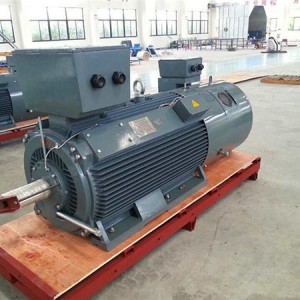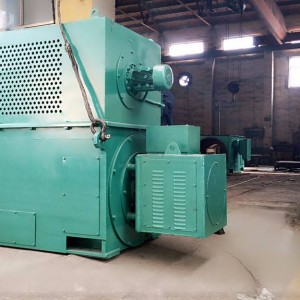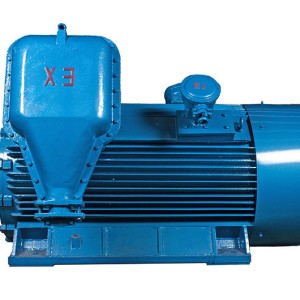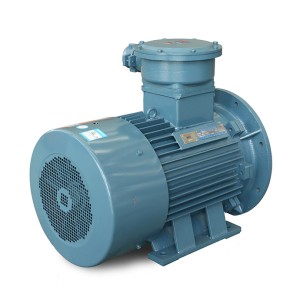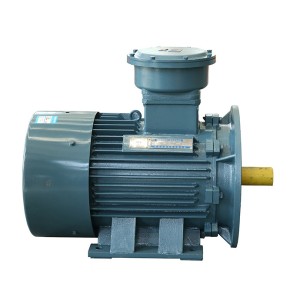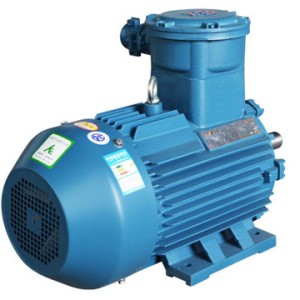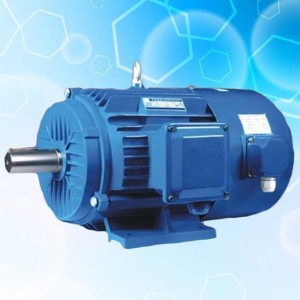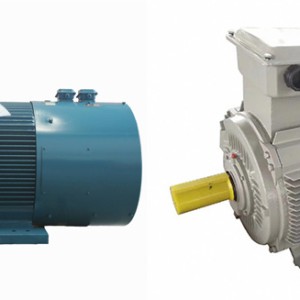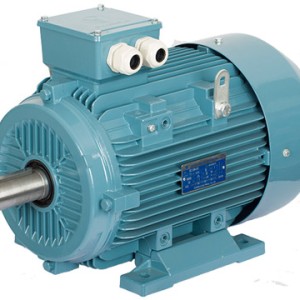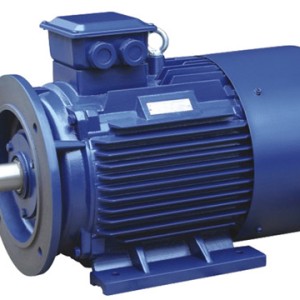1. Ordinary asynchronous motors are designed according to constant frequency and constant voltage, and it is impossible to fully meet the requirements of variable frequency speed regulation. The following is the influence of the inverter on the motor
(1) The efficiency and temperature rise of the motor
Regardless of the type of frequency converter, different levels of harmonic voltage and current are generated during operation, so that the motor runs under non-sinusoidal voltage and current. According to the information, taking the commonly used sine wave PWM inverter as an example, its low-order harmonics are basically zero, and the remaining high-order harmonic components about twice the carrier frequency are: 2u+1 (u is the modulation ratio).
Higher harmonics will cause the increase of stator copper loss, rotor copper (aluminum) loss, iron loss and additional loss, the most notable being the rotor copper (aluminum) loss. Because the ordinary asynchronous motor rotates at a synchronous speed close to the fundamental frequency, the high-order harmonic voltage will generate a large rotor loss after cutting the rotor bar with a large slip. In addition to this, additional copper losses due to the skin effect need to be considered. These losses will make the motor additionally generate heat, reduce the efficiency, and reduce the output power. For example, if an ordinary three-phase asynchronous motor is operated under the condition of a non-sinusoidal power supply output by the inverter, its temperature rise will generally increase by 10%~20%.
(2) The problem of the insulation strength of the motor
At present, many small and medium-sized inverters use PWM control methods. Its carrier frequency is about several thousand to ten kilohertz, which makes the motor stator windings have to withstand a high voltage rise rate, which is equivalent to applying a steep impulse voltage to the motor, which makes the inter-turn insulation of the motor more resistant. ordeal. In addition, the rectangular chopper impulse voltage generated by the PWM inverter is superimposed on the motor operating voltage, which will pose a threat to the motor’s ground insulation, and the ground insulation will accelerate aging under the repeated impact of high voltage.
(3) Harmonic electromagnetic noise and vibration
When an ordinary asynchronous motor is powered by a frequency converter, the vibration and noise caused by electromagnetic, mechanical, ventilation and other factors will become more complicated. The time harmonics contained in the variable frequency power supply interfere with the inherent space harmonics of the electromagnetic part of the motor to form various electromagnetic excitation forces. When the frequency of the electromagnetic force wave is consistent with or close to the natural vibration frequency of the motor body, a resonance phenomenon will occur, thereby increasing the noise. Due to the wide operating frequency range of the motor and the wide range of rotational speed variation, it is difficult for the frequencies of various electromagnetic force waves to avoid the natural vibration frequency of each component of the motor.
(4) The adaptability of the motor to frequent starting and braking
After the inverter is used for power supply, the motor can be started at a very low frequency and voltage without inrush current, and the various braking methods provided by the inverter can be used for rapid braking, in order to achieve frequent starting and braking The conditions are created, so the mechanical system and electromagnetic system of the motor are under the action of cyclic alternating force, which brings fatigue and accelerated aging problems to the mechanical structure and insulation structure.
(5) Cooling problem at low speed
First of all, the impedance of ordinary asynchronous motors is not ideal. When the frequency of the power supply is low, the loss caused by the higher harmonics in the power supply is large. Secondly, when the speed of ordinary asynchronous motors decreases, the cooling air volume decreases in proportion to the cube of the speed, which causes the low-speed cooling of the motor to deteriorate, and the temperature rise increases sharply, making it difficult to achieve constant torque output.
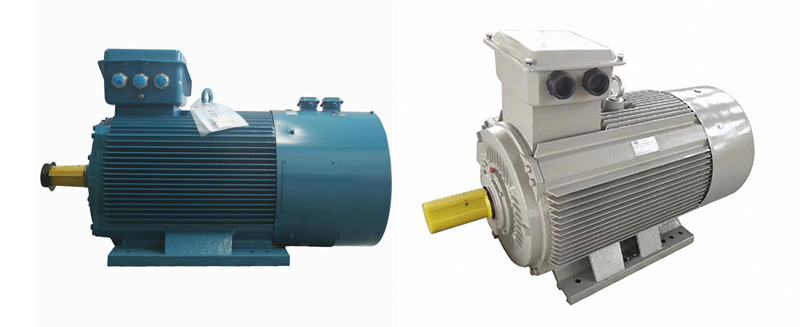
Second, the characteristics of variable frequency motor
(1) Electromagnetic design
For ordinary asynchronous motors, the main performance parameters considered when redesigning are overload capacity, starting performance, efficiency and power factor. The variable frequency motor, because the critical slip is inversely proportional to the power frequency, can be started directly when the critical slip is close to 1. Therefore, the overload capacity and starting performance do not need to be considered too much, but the key problem to be solved is how to improve the motor pair. Adaptability to non-sinusoidal power supplies. The method is generally as follows:
1) Reduce the stator and rotor resistance as much as possible.
Reducing the stator resistance can reduce the copper loss of the fundamental wave to make up for the increase in copper loss caused by higher harmonics.
2) In order to suppress the high-order harmonics in the current, the inductance of the motor needs to be appropriately increased. However, the leakage reactance of the rotor slot is large, the skin effect is also large, and the copper loss of high-order harmonics also increases. Therefore, the size of the leakage reactance of the motor should take into account the rationality of impedance matching in the entire speed regulation range.
3) The main magnetic circuit of the variable frequency motor is generally designed to be unsaturated. One is to consider that higher harmonics will deepen the saturation of the magnetic circuit, and the other is to appropriately increase the output voltage of the inverter in order to increase the output torque at low frequencies.
(2), structural design
When designing the structure again, the influence of the non-sinusoidal power supply characteristics on the insulation structure, vibration, noise cooling method, etc. of the variable frequency motor is mainly considered. Generally, pay attention to the following issues:
1) Insulation grade, generally F grade or higher, strengthen the insulation strength to ground and turns, especially consider the ability of insulation to withstand impulse voltage.
2) For the vibration and noise of the motor, the rigidity of the motor components and the whole should be fully considered, and the natural frequency should be increased as much as possible to avoid resonance with each force wave.
3) Cooling method: Forced ventilation is generally used for cooling, that is, the main motor cooling fan is driven by an independent motor.
4) Measures to prevent shaft current, bearing insulation measures should be adopted for motors with a capacity exceeding 160KW. The main reason is that it is easy to produce asymmetrical magnetic circuit, and also produces shaft current. When the currents generated by other high-frequency components work together, the shaft current will increase greatly, resulting in bearing damage, so insulation measures are generally taken.
5) For constant power variable frequency motors, when the speed exceeds 3000/min, special grease with high temperature resistance should be used to compensate for the temperature rise of the bearing.
3. Comparison of practical applications
(1). The efficiency and temperature rise of the motor are driven by variable frequency, and the efficiency of the variable frequency motor will be about 10% higher, while the temperature rise will be about 20% smaller, especially in the low frequency region of vector control or direct torque control.
(2). Frequency conversion motors are better than ordinary motors for occasions requiring frequent starting, frequent speed regulation, and frequent braking.
(3). In terms of electromagnetic noise and vibration, variable frequency motors have lower noise and less electromagnetic vibration than ordinary motors when driven by variable frequency.
(4). Dielectric strength of the motor. Since the frequency conversion motor is specially designed for the frequency converter drive, it can withstand a large du/dt, so the insulation strength of the frequency conversion motor is higher. Especially in the DTC control mode, the insulation strength of the motor is a big test.
(5). The main difference is that the variable frequency motor has additional heat dissipation (using an independent axial fan for forced ventilation), and the heat dissipation in low frequency, DC braking and some special applications is much better than that of ordinary AC asynchronous motors.
Post time: 2022-02-14


